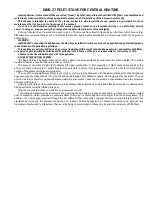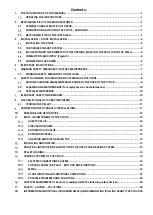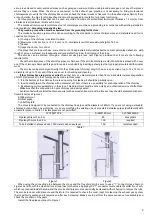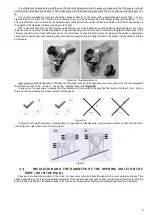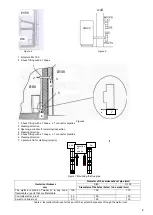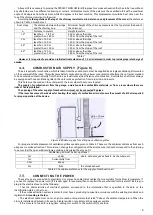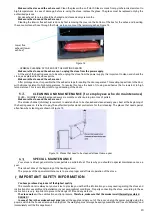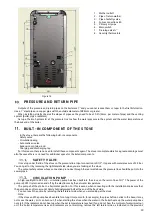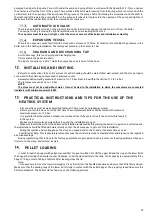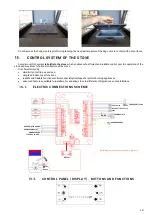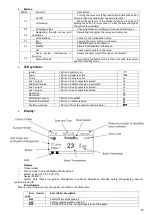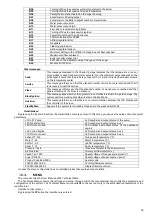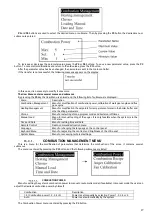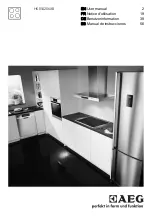
2
- Instructions for use and maintenance issued by the manufacturer of the stove (if such instructions are not provided with
the stove),
- The documentation necessary to comply with the existing standards.
INSTALLATION – STOVE INSTALLATION
Responsibility for the work carried out at the place of connection is entirely on the user.
Before one turns the stove on, the installer must meet all legal standards of safety, as well as the following requirements:
- to check that setting up the stove complies with local, national, and European regulations,
- that the location of setting up the stove meets the requirements set forth in this manual,
- to set up the flue pipes,
- that air intake matches the type of the installed stove,
- that the electrical connections are not set up using temporary and/or not insulated electrical cables,
- to evaluate the effectiveness of grounding electrical systems,
- to always use personal protective equipment and all means of protection that are prescribed by local regulations,
- to always provide sufficient service space required for any maintenance and repair of stoves
INSTALLING THE STOVE
We recommend you to unpack the stove only when the stove is set up in the position where it will be connected.
The stove is on the plastic pins that have M10 bolts (4 items), that are threaded into the stove base. At the screws there
are M10mm threaded nuts to the plastic parts. The legs are wound up all the way to the base of the stove. After unpacking the
stove, when you put it in a place where it will be located, it is necessary to unscrew all the legs, so that a total height from the
floor to the base of the stove is about 25mm. When you are done with nivelation of the stove that needs to stand horizontally,
tighten the nuts with a 17 wrench, which needs to approach the base of the furnace, and at the same time hand-holding the
plastic part of the legs, tighten the nut. The height of about 25mm from the floor to the base is needed for better circulation of
air and cooling the stove. In this way you protect the stove from overheating and you extend its life.
If the surrounding walls and/or floors are made of materials that are not resistant to heat, then one should use adequate
protection using the insulating material that does not burn.
In order to protect the building construction against the risk of fire, flammable elements (such as walls, doors, furniture, home
appliances…) must be kept on the safe distance from the stove: 100 mm from the rear side, 200 mm from the lateral sides and
800 mm from the front side. Always leave at least 100 mm between the rear side of the stove and the wall to allow for proper
air circulation, or for the air to flow properly in that area. To protect the floor if it is made of combustible materials (wood,
parquet, linoleum, laminates, carpets…), we suggest you put a metal plate under the stove on the floor with the thickness of 3-
4 mm that will stretch 300 mm in front of the stove. Any elements made from wood (e.g. beams) or other combustible material
located near the stove
should be protected/covered with fireproof material.
Leave enough clearance for maintenance work.
If the stove is installed in a kitchen with a trellis for drawing out air or if it is placed in the room with appliances that use
solid fuel (such as a wood burning stove), always make sure that the amount of inlet air in the room is sufficient to ensure safe
operation of the stove.
If a smoke channel goes through the ceiling, it should be properly thermally insulated using the protection out of insulating
materials that does not burn. When the stove is set up into place, it should be levelled using pins.
DANGER !
The exhaust gas Armour must not be connected to:
- the smoke pipe used by another heat generator (boilers, furnaces, fireplaces, stoves, etc.),
- the air drawing system (grilles, ventilation openings, etc), even if the system is inserted into the drain pipe.
DANGER !
It is forbidden to install shut-off valves for the flow (draft) of air (flap valves that can prevent airflow or disable drafts).
ATTENTION
If the ejection path of smoke creates such a bad draft, of a bad flow of air (many curves, improper completion of the ejection
of smoke, constriction, etc.) discharge of smoke can be bad, or in a situation like this smoke discharging is not as good as it
could be.
The smoke ejection system from the stove operates under negative pressure in the stove chamber and with mild pressure
from the smoke drain pipe. It is very important that the smoke extraction system is hermetically closed (sealed). This requires
the use of a smooth tube on the inside. First of all you must carefully study the plan and structure of the room when the smoke
extraction pipe is set up through the walls and roof, so that the installation of pipes is performed properly in accordance with
the standards of fire protection.
You should first ensure that the room where the stove is located has enough air for combustion. It is advisable to
periodically performs check so as to ensure that the combustion air comes right up to the combustion chamber. The stove
operates at 230 V ~ 50 Hz. Make sure that the electrical cord is not underneath the furnace, to be away from the stove, to be
away from hot spots, and not to touch any sharp edges that it could interdict. If the stove is electrically overloaded, this can
lead to shortening of the lifetime of the electronics of the stove.
Never turn off the power supply by pulling the plug when there is a burning flame in the stove. This could jeopardize the
proper functioning of the stove.
THE SMOKE EXHAUST SYSTEM
The smoke exhaust must be carried out in accordance with existing standards. Exhaust gas tube should be well sealed
(see Figures 1-7).
For smoke exhaustion, one can also use classic brick chimneys while flues can also be made of pipes that need to be well
insulated (double wall) and sealed, to avoid creating condensation in them.
The drain tube absolutely must not be connected to other systems of any kind, such as the systems where the smoke is
removed from the combustion chamber, exhaust grilles or air distribution system, etc. Also, the smoke exhaust must not be


